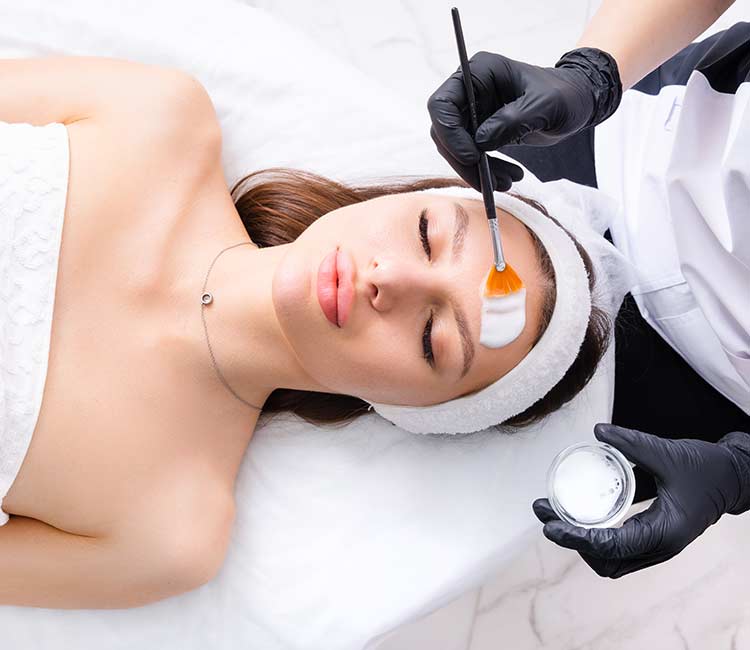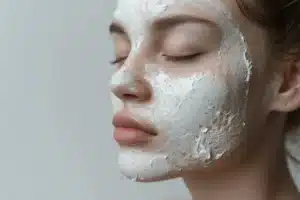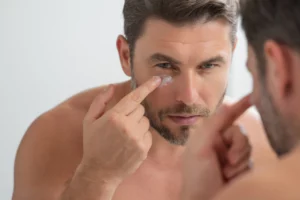A facial peel is a technique designed to eliminate dead surface skin cells—and in some cases, cells from deeper layers—to promote cellular renewal. This treatment involves applying an exfoliating chemical solution, typically containing acids, which penetrates the skin and induces a more or less intense exfoliation, depending on the type of peel used.
The peel improves skin texture, reduces pigmentation spots, fine lines, and scars, while evening out the complexion. It is especially recommended for individuals looking to restore radiance, enhance skin firmness, and correct imperfections caused by aging or sun exposure.
Le peeling du visage est un traitement efficace et non invasif pour améliorer la qualité de la peau, lisser les imperfections et redonner de l’éclat au teint. Adapté à divers types de peau et à différents problèmes cutanés, ce soin peut être personnalisé pour répondre aux besoins spécifiques de chaque
patient's specific needs. If you're considering a facial peel in Geneva, consult an experienced doctor for a personalized diagnosis and optimal results.

The mechanism of action of a facial peel is based on the controlled exfoliation of the superficial to deeper layers of the skin, with the aim of stimulating cell renewal and tissue regeneration. Depending on the type of peel (superficial, medium, or deep) and the method used (chemical or laser), the approach varies slightly, but the principle remains the same : induce peeling and promote the development of denser, more radiant skin.
Indeed, the peel stimulates the production of collagen and elastin—proteins essential for maintaining the skin’s firmness and elasticity. The treatment results in a more radiant complexion and visibly smoother, younger-looking skin.
The level of peel penetration depends on the type of acid used (for a chemical peel) or the laser settings applied (for a laser peel), allowing the treatment to be tailored to each skin type and concern.
• Superficial peel : il utilise des acides doux comme l’acide glycolique pour exfolier la couche superficielle de la peau. Il est idéal pour raviver l’éclat du teint et affiner le grain de peau sans éviction sociale.
• Medium peel : à base d’acide trichloracétique (TCA), ce type de peeling pénètre plus profondément pour traiter les rides légères, les cicatrices pas très profondes, les taches pigmentaires et améliorer la fermeté de la peau.
• Deep peel : often performed with phenol, this type targets deeper wrinkles, more pronounced scars, and significant skin irregularities. It requires a longer recovery period but delivers long-lasting results.
Le peeling chimique, comme son nom l’indique, utilise des agents chimiques pour exfolier la peau. Selon les besoins du patient, différents types d’acides peuvent être utilisés pour atteindre la profondeur souhaitée.
Laser peel uses a beam of light to vaporize layers of skin. The laser allows for highly precise control in terms of penetration depth, and therefore exfoliation.
Laser treatments often provide more accuracy than chemical peels and visibly tighten the skin.

A facial peel is indicated for a variety of skin concerns and can be customized to suit each patient's needs.
• Dull complexion, instant glow : after just one session, the skin appears more radiant and regains a fresh tone. A true glow-boosting effect.
• Reduction of wrinkles and fine lines : medium and deep peels help smooth fine lines and reduce deeper wrinkles.
• Improvement of skin texture : peels make the skin smoother and softer while refining skin texture.
• Diminishing pigmentation spots : such as sunspots, age spots, and uneven pigmentation.
• Rejuvenation : by stimulating collagen production, a peel enhances skin elasticity and provides a subtle lifting effect.
• Treatment of acne and scars : salicylic acid peels are particularly effective at reducing excess sebum and inflammatory acne lesions. Medium and deep peels help improve acne scars.
Although peels are primarily used on the face, they can also be applied to other areas of the body affected by skin imperfections. The most commonly treated areas include :
• Face : to even out the skin tone, smooth texture, and target spots and wrinkles.
• Neck : to firm the skin and reduce visible signs of aging.
• Décolleté : to fade sunspots and enhance skin elasticity.
• Hands : to treat age spots and smooth the skin.
• Back : to treat acne and scarring in an area often prone to blemishes.

A facial peel session lasts on average between 10 and 15 minutes.
• Initial consultation : before the session, Dr. Romano performs a skin assessment to determine the most suitable type of peel based on your needs and skin type.
• Skin cleansing : before applying the chemical solution, the skin is thoroughly cleansed to remove any impurities. In some cases, it will also be degreased.
• Application of the peeling solution : the exfoliating solution is applied to the skin using a brush. The exposure time varies depending on the type of peel and skin sensitivity.
• Neutralization and hydration : once the application time has passed, the solution is neutralized and a soothing cream is applied to hydrate the skin.
• Sun protection : a sunscreen is applied to protect the freshly exfoliated skin from UV rays.

Before undergoing a facial peel, it is important to follow certain recommendations to prepare the skin for treatment and avoid irritation and side effects.
• Avoid sun exposure : for at least 3 weeks before treatment for a superficial peel, and 2 months before treatment for a medium or deep peel, it is crucial to avoid any sun exposure and to apply SPF 50 sunscreen to prevent burns and post-treatment hyperpigmentation. In general, peels are not performed on tanned skin.
• Discontinue exfoliating treatments : stop using products containing exfoliating acids (AHAs, BHAs, retinoids) several days before the peel. Doctor Romano will advise you on the appropriate timeframe based on your skin type and the peel used.
• Hydrate your skin : your skin should be well hydrated before the session. It is best not to perform a peel on dry skin.
• For men : shave the day before the peel.

After a facial peel, the skin is often more sensitive, so it is essential to take steps to protect and hydrate it.
ès une séance de peeling moyen ou profond.
• Apply sun protection : use an SPF 50 sunscreen and avoid direct sun exposure for at least 2 weeks after a superficial peel and 3 months after a medium or deep peel.
ès une séance de peeling moyen ou profond.
• Hydrate deeply : use healing moisturizers to support cell regeneration and healing. Dr. Romano will prescribe specific creams.
ès une séance de peeling moyen ou profond.
• Avoid harsh products : do not use exfoliating products or retinoids for at least 3 weeks after a superficial peel and 3 months after a medium or deep peel.
ès une séance de peeling moyen ou profond.
• Avoid occlusive makeup : for 24 to 48 hours, limit the use of makeup to allow the skin to breathe.
The results of a facial peel are generally visible after the first session, with a more radiant complexion, refined skin texture, and smoother surface.
For medium and deep peels, results are noticeable two weeks after the procedure (once the healing process is complete), and optimal after 4 to 6 months (the time required for neocollagenesis).
For superficial peels, to achieve optimal and lasting results, it is often recommended to undergo 3 to 6 sessions spaced a few weeks apart.
The effects of the peel—particularly on wrinkles, pigmentation, and overall skin tone—continue to improve over time.
The price of a facial peel is 200 CHF per session at Dr. Romano’s clinic in Geneva. This treatment is carried out in a strictly medical setting, either by the doctor herself or by her nurse assistant, who is trained in specific protocols. The frequency and number of sessions may vary depending on the indication, the initial condition of the skin, and the desired goals. Each treatment is approached individually, taking into account the specific characteristics of each patient’s skin.
Patients who have opted for a facial peel say they are satisfied with the results. In particular, they observe a rapid improvement in the radiance of the complexion and a visible reduction in imperfections.
Les peelings superficiels sont souvent appréciés pour leur effet “coup d’éclat”, $ les peelings moyens et profonds pour les résultats plus durables sur les rides et les taches. Pour un peeling superficiel, le temps de récupération minimal est un autre avantage souvent mentionné par les patients, qui peuvent reprendre rapidement leurs activités normales.
The best peel depends on your skin's specific needs. For dull skin and enlarged pores, a superficial peel with glycolic or lactic acid is ideal. For pigmentation spots or moderate wrinkles, a medium peel with trichloroacetic acid (TCA) offers deeper action. For deep wrinkles or scars, a deep peel is the only truly effective option.
• Superficial peel : uses mild acids (glycolic, lactic, mandelic acid) to exfoliate the epidermis, smooth skin texture, and boost radiance.
• Medium peel : penetrates the upper dermis (TCA, salicylic acid) to treat fine lines, pigmentation, and moderate scars.
• Deep peel : works on the deep dermis, mainly using phenol, to correct deep wrinkles, scars, and significant skin damage.
Le choix dépend du type de peau, de la sensibilité cutanée et des objectifs recherchés. Une peau sensible nécessitera un peeling doux, tandis qu’une peau épaisse ou sujette aux imperfections pourra bénéficier d’un peeling plus appuyé. Une consultation préalable avec un médecin est essentielle pour définir le traitement le plus adapté.
• Superficial peel : every 4 to 6 weeks.
• Medium peel : every 6 to 12 months.
• Deep peel : typically once, with optional maintenance treatments.
• Superficial : 1 to 3 days with light flaking.
• Medium : 7 to 10 days with redness, peeling, and tightness.
• Deep : 2 to 3 weeks with specific aftercare and increased caution.
After a peel, it is important to :
• Use a soothing, restorative moisturizer rich in calming ingredients.
• Apply daily SPF 50 sunscreen to protect the skin.
• Avoid sun exposure, hot baths, saunas, and makeup for a few days.
• Do not pick at flaking skin—let it peel naturally.
Oui, le peeling peut être associé à d’autres soins comme la mésothérapie, le microneedling, le PRP ou des traitements laser. Cependant, il est essentiel d’espacer les séances et de respecter les conseils du médecin pour éviter toute irritation.